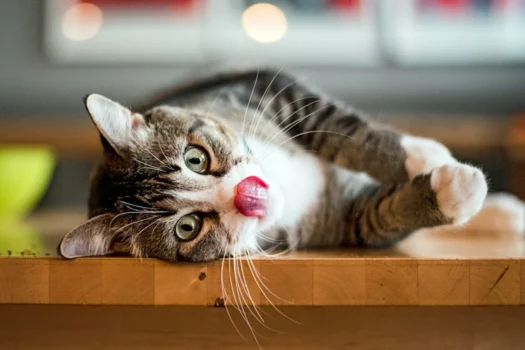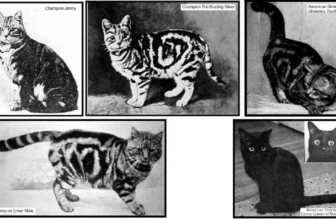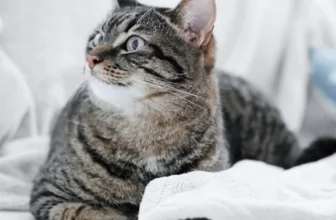As American Shorthair cats are generally known for their friendly and affectionate nature, encountering aggressive behavior in them can be a perplexing and concerning experience for their owners. Aggression in cats can stem from various underlying causes and manifests itself in different ways. It is essential to understand the reasons behind your cat’s aggressive behavior to manage it effectively. In this article, we will discuss the various causes and signs of aggression in American Shorthairs and provide you with some tips on how to manage it.
Causes of Aggressive Behavior
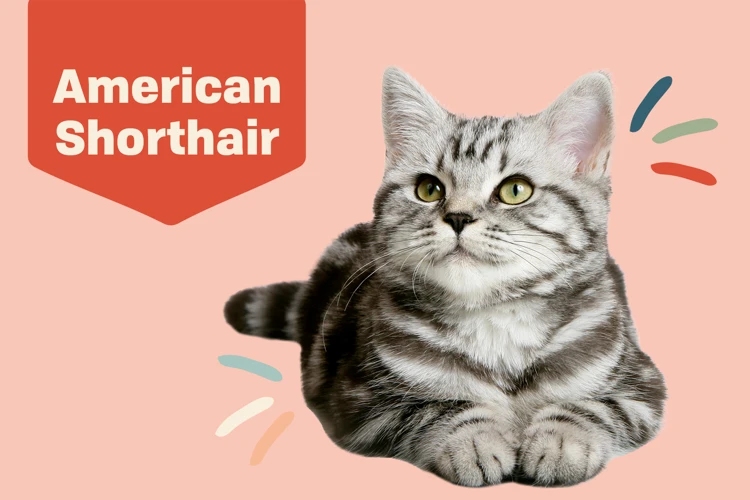
Understanding the causes of aggressive behavior in American Shorthairs can be perplexing for their owners. It’s important to recognize that feline aggression is a common issue that can be caused by numerous factors, including physical discomfort, anxiety, territorial behaviors, or boredom. By identifying these causes, you can better manage your cat’s behavior and create a safe and comfortable living environment for them. Let’s take a closer look at some of these causes and how to address them. For solutions on aggressive behavior, you can check out our article on American Shorthair Behavior Solutions.
Physical Discomfort or Pain
Physical discomfort or pain can be a major cause of aggressive behavior in American Shorthairs. When they are in pain or suffering from an illness, they can become irritable and aggressive. It is important to observe your cat’s behavior and look for signs of physical discomfort to identify and address the issue.
Symptoms of physical discomfort in American Shorthairs:
| Symptom | Description |
|---|---|
| Decreased appetite | If your cat is experiencing pain, they may lose interest in food. |
| Limping or favoring one paw | Cats in pain may walk with a limp or avoid putting weight on a particular limb. |
| Excessive licking or grooming | Cats in pain may overgroom themselves or compulsively lick a particular area. |
| Growling or hissing when touched | If your cat is in pain, they may become agitated and respond aggressively to physical touch. |
If you notice any of these symptoms, it is important to take your cat to the veterinarian as soon as possible to identify and treat any underlying medical conditions. For more information about taking care of your American Shorthair, please refer to our article on playtime and exercise, vocalizations, and training tips and tricks.
Fear or Anxiety
Many American Shorthairs may display aggressive behavior out of fear or anxiety. This is a common cause of aggression among cats, and it can be difficult for owners to understand and manage. Here are a few potential reasons why an American Shorthair may exhibit aggression due to fear or anxiety:
- Past Trauma: If your American Shorthair has experienced some form of trauma, such as abuse or neglect, they may be prone to aggressive behavior. This could be triggered by certain situations or stimuli, such as loud noises or sudden movements.
- Lack of Socialization: If your American Shorthair was not properly socialized as a kitten, they may be fearful or anxious in new situations or around unfamiliar people or animals. This can lead to aggression as a defensive response.
- Medical Issues: Some American Shorthairs may become aggressive due to underlying medical issues, such as urinary tract infections or dental problems. Pain or discomfort can cause a normally docile cat to become irritable and lash out.
It’s important to note that fearful or anxious American Shorthairs may display different types of aggression depending on the situation. They may hiss or growl, try to run away, or even lash out with their claws or teeth. As an owner, it’s important to be aware of these signs and work to address the underlying cause of the behavior.
If your American Shorthair is exhibiting aggression due to fear or anxiety, there are several steps you can take to manage the behavior. It’s important to consult with a veterinarian to rule out any underlying medical issues that could be contributing to the behavior. From there, you can work on providing your cat with a safe and comfortable environment that reduces fear and anxiety. This may include providing hiding spaces or high perches for your cat to retreat to, as well as providing ample stimulation and playtime to keep your cat mentally and physically engaged. Consistent training and positive reinforcement can also help to manage your American Shorthair’s fear and anxiety, and should always be used in place of punishment or physical action.
Protecting Territory or Resources
American Shorthairs are natural hunters and have a strong instinct to protect their territory and resources. This can sometimes lead to aggressive behavior towards other animals or even humans. It is important to understand the reasons behind this behavior in order to properly manage it.
Reasons for Protecting Territory
Territorial aggression is often exhibited when a new animal is introduced into the home or when a current animal feels its territory is being threatened. This can also occur when the cat perceives a threat to its food, water, or sleeping areas.
Reasons for Protecting Resources
Resource guarding may occur when the cat feels that its food, water, toys, or other possessions are being threatened or taken away. This is a natural behavior for cats, as in the wild they would need to defend their resources from other animals.
Signs of Territory or Resource Guarding
It is important to recognize the signs of territorial or resource guarding in order to prevent aggressive behavior. These signs may include:
| Signs of Territory Guarding | Signs of Resource Guarding |
| Stalking or pouncing on other animals | Growling or hissing when approached near food or toys |
| Blocking access to certain areas | Showing aggression when another animal approaches |
| Swatting or hissing when other animals come near | Gulping food down quickly when others are present |
| Not allowing other animals to approach | Running away to hide with a possession |
Managing Aggression due to Territory or Resource Guarding
If your American Shorthair is exhibiting aggressive behavior due to territorial or resource guarding, there are certain steps you can take to manage the behavior.
Firstly, it is important to provide enough resources and space to avoid competition between pets. Make sure that each animal in the house has its own separate food and water dishes, litter boxes, and sleeping areas.
Secondly, avoid punishing the cat for exhibiting territorial or resource guarding behavior, as this may actually exacerbate the behavior. Instead, provide positive reinforcement for good behavior and try to redirect the cat’s attention to appropriate toys or activities.
Finally, if the aggressive behavior due to territorial or resource guarding continues despite your efforts, it may be necessary to consult with a veterinarian or animal behaviorist to determine the best course of action.
Understanding and properly managing territorial or resource guarding behavior in American Shorthairs can help create a harmonious and safe home environment for both the cat and its companions.
Boredom or Lack of Stimulation
Cats, particularly American Shorthairs, are known for their playful nature. They are active and curious animals who love to play, explore, and be mentally stimulated. Without proper stimulation, they can become bored and restless, which can lead to aggressive behavior. So, if you feel that your cat is behaving aggressively due to boredom or lack of stimulation, here are some possible reasons to consider:
- Lack of Playtime: If your cat is not getting enough playtime, they may become aggressive. American Shorthairs are highly active and playful, and they need at least 15-20 minutes of playtime twice a day. If you are unable to provide playtime, you may consider getting your cat interactive toys that can keep them engaged and entertained even when you are not around.
- Monotonous Environment: A monotonous environment can make your cat feel bored and lead to aggressive behavior. Try providing your cat with an enriched environment by adding new toys, cat trees, scratching posts, and different types of furniture to keep them mentally stimulated. Additionally, providing them with a view of the outside world can also help stimulate their senses.
- Lack of Socialization: Cats are social animals and require social interaction to maintain their mental well-being. If your American Shorthair cat is not socialized, they may become aggressive towards people and other animals. They require frequent interactions with family members and other pets, so make sure they’re given enough opportunities to socialize with others.
- Dietary Needs: A poor diet or lack of essential nutrients in your cat’s food can also lead to aggression. Make sure your cat is eating high-quality cat food that meets their nutritional needs. Additionally, you can also provide them with healthy treats to keep them happy.
Boredom or lack of stimulation can make an American Shorthair cat irritable and aggressive. Thus, it is essential to take measures to keep them entertained and engaged at all times. This will not only help keep them happy but will also prevent aggressive behavior.
Signs of Aggression
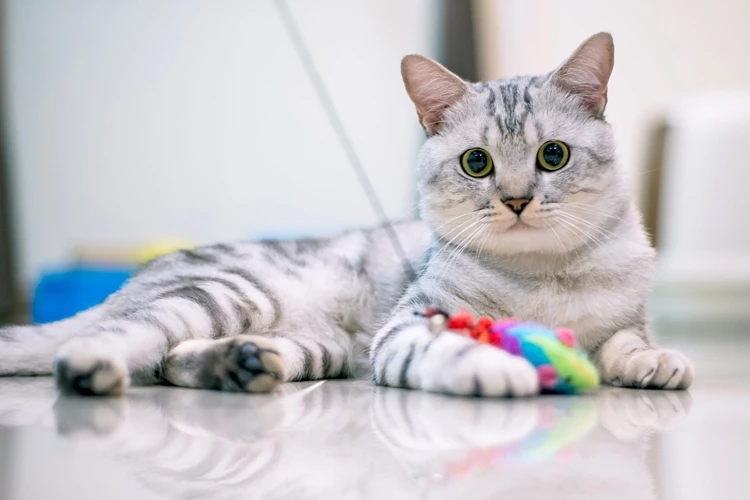
As a cat owner, it’s crucial to understand the subtle and not-so-subtle signs of your furry friend’s behavior. While some breeds may be more prone to displaying aggressive behavior than others, it’s important to recognize the signs of aggression in all cats. Aggression in American Shorthairs may manifest in a variety of ways, from body language to verbal cues and physical actions. By being aware of these signs, you can take steps to manage and prevent aggressive behavior in your furry friend. Let’s dive into some of the noteworthy signs of aggression in American Shorthairs.
Body Language
When it comes to understanding aggressive behavior in American Shorthairs, paying attention to their body language is crucial. Here are some body language cues to look out for:
- Hissing: This is a clear sign of aggression in cats. When they hiss, they are warning you to back off.
- Flattened ears: When their ears are flattened, it is a sign that they are feeling threatened or defensive.
- Puffing up: If your American Shorthair is puffing up its fur, it’s trying to make itself look bigger and more intimidating.
- Tail position: A cat holding its tail high and straight up in the air is feeling confident, while a low or tucked tail indicates fear or submission. A constantly twitching tail can also be a sign of agitation.
- Dilated pupils: If your cat’s pupils are dilated, it can mean that they are feeling threatened or agitated.
As an owner, it’s important to recognize these cues and act accordingly. For example, if your American Shorthair is hissing and puffing up its fur, it’s best to give them space and avoid any sudden movements. Similarly, if their ears are flattened and their pupils are dilated, it’s a good idea to back off until they feel safe and comfortable again.
Remember, understanding your cat’s body language is just one aspect of managing their aggressive behavior. It’s important to also address the underlying causes and provide appropriate training and positive reinforcement. By doing so, you can create a safe and happy environment for both you and your American Shorthair.
Verbal Cues
When it comes to aggressive behavior in American Shorthairs, it’s important to pay attention to verbal cues as they can provide valuable insight into your cat’s disposition. Verbal cues include any vocalizations your cat might make, such as growling, hissing, or meowing in a distinct and unusual tone. Here are some common verbal cues to look out for and what they might indicate:
| Verbal Cue | Possible Indication |
|---|---|
| Growling | Your cat is feeling threatened or territorial and is warning others to stay away. |
| Hissing | Similar to growling, hissing is a warning that your cat feels threatened. It can also be an expression of fear or frustration. |
| Meowing in a low, guttural tone | This can be a sign of pain or discomfort. If your cat typically meows in a different tone, it’s worth investigating to see if there is an underlying health issue. |
| High-pitched meowing or yowling | Your cat may be feeling anxious or stressed. This type of meowing is often seen in cats who are experiencing separation anxiety or are in a new environment. |
It’s important to note that while these verbal cues can provide insight into your cat’s mood and potential aggression, they can also be influenced by other factors such as hunger, boredom, or excitement. It’s always a good idea to take a holistic approach when deciphering your cat’s behavior. Pay attention to body language, physical actions, and environmental factors in combination with verbal cues to get a better understanding of what your cat might be trying to communicate.
Physical Actions
When it comes to identifying aggressive behavior in American Shorthairs, observing their physical actions is an important part of the process. Some common physical actions that may indicate aggression in cats include:
- Growling: This is a low, guttural sound that cats make to warn others that they are feeling threatened or angry. It can be accompanied by stiff body posture and bared teeth.
- Hissing: A hissing sound usually means that the cat is feeling scared or threatened, but can also indicate aggression. The cat will usually arch its back and puff up its fur to appear larger.
- Swatting and Scratching: When cats feel threatened or angry, they may swat at or scratch those around them. This can often happen when the cat feels trapped or cornered and is trying to defend itself.
- Biting: Biting is a more serious form of aggression and can cause harm to both humans and other animals. It can be a response to fear, overstimulation, or territorial behavior.
It’s important to remember that while these physical actions may indicate aggression, they can also be a response to other emotions such as fear or anxiety. It’s important to consider any additional cues such as body language or verbal cues to fully understand what the cat is feeling.
How to Manage Aggressive Behavior
As an owner of an American Shorthair with aggressive behavior, it’s important to learn how to manage this behavior to ensure the safety of both your pet and those around them. There are several steps you can take to address the underlying causes of your cat’s aggression and manage their behavior in a positive way. Let’s dive into some practical ways you can help your American Shorthair overcome their aggressive tendencies.
Consult with a Veterinarian
When you notice aggressive behavior in your American Shorthair, the first thing you should do is seek professional help. A veterinarian can help you identify any underlying health issues that may be causing your cat’s aggressive behavior.
Here are some reasons why you should consult with a veterinarian:
| Reason | Explanation |
| Health Issues | Aggression can be a symptom of underlying health issues like infections, injuries, or pain. |
| Medical Conditions | Certain medical conditions like hyperthyroidism, brain tumors, or seizures can also cause aggression in cats. |
| Medication | Some medications can cause aggressive behavior in cats. A vet can adjust the dosage or recommend a different medication. |
| Behavioral Assessment | Veterinarians who specialize in behavior can assess your cat’s behavior and develop a personalized treatment plan. |
Your veterinarian can offer advice on how to deal with any aggressive behavior you encounter; they can recommend the training techniques and other strategies to help reduce the behavior. They can also examine your cat’s living space and provide modifications that can reduce anxiety and aggression. Remember, your cat’s aggression might cause injury to you and your family.
However, it is essential to bear in mind that aggression is a common and manageable issue found in American Shorthair cats.
Provide Appropriate Stimulation
To prevent aggressive behavior in American Shorthairs, it’s important to provide them with appropriate stimulation. A lack of stimulation can lead to boredom, frustration and aggression in cats. Here are some ways to increase activity and mental stimulation:
- Interactive toys: Toys that require your cat’s participation, such as puzzle feeders, can keep them entertained and mentally stimulated. Make sure to supervise your cat during playtime to prevent accidents.
- Scratching posts: Scratching is a natural behavior for cats, and providing a designated scratching post can prevent them from damaging furniture and other household items. Make sure the post is tall enough for your cat to fully stretch and use, and consider adding catnip or a cat attractant to make it more appealing.
- Outdoor access: If possible, allow your cat to spend time outdoors in a safe and enclosed area. Fresh air and natural sights and smells can be enriching for indoor cats.
- Window perches: Providing a window perch for your cat to observe the outside world can prevent boredom and encourage natural behaviors like hunting and stalking.
Remember, a lack of stimulation can lead to negative behavior in cats. It’s important to provide them with a variety of activities to keep them happy and healthy.
Be Consistent with Training
Training is a critical aspect of managing aggressive behavior in American Shorthairs. Consistency is key when it comes to training. One of the best ways to achieve consistency is to develop a routine and stick to it. Keep training sessions short and frequent, and use positive reinforcement to encourage good behavior.
It’s essential to use the same training techniques every time and to have all members of the household consistently enforce the rules. To help with consistency, create a list of rules and guidelines that everyone can refer to and follow. Make sure your tone and body language are the same every time you give a command or correction.
Always use clear, simple commands and avoid confusing or contradictory directions. Reinforce good behavior by rewarding your American Shorthair with praise, treats or playtime. Stay calm and avoid becoming frustrated or angry when your cat doesn’t listen or behaves aggressively. Negative energy can exacerbate the problem.
Training your American Shorthair to walk on a leash, scratch on a scratching post instead of furniture, and come when called can also help reduce aggressive behavior. Keep in mind that training takes time and patience, and it’s essential to start when your cat is young and impressionable.
By being consistent with training, you set clear boundaries and provide structure for your American Shorthair. This leads to a more obedient, well-behaved, and ultimately less aggressive cat.
Use Positive Reinforcement
Positive reinforcement is one of the most effective ways to manage aggressive behavior in American Shorthairs. It involves rewarding your cat for desired behaviors instead of punishing them for undesirable ones. By doing so, you’ll be reinforcing the behavior you want them to display, while discouraging aggression.
To use positive reinforcement, you need to start by identifying positive behaviors that you would like to encourage. Examples of desirable behaviors include calmness, affection, and playfulness. Using treats, praise, or playtime will motivate your cat to perform these behaviors more often.
The key to positive reinforcement is timing. You need to reward your cat immediately after they perform the desired behavior. This will help them associate the reward with the action, making them more likely to repeat it in the future.
Here is a table outlining some options for positive reinforcement:
| Reward | Desirable Behavior |
|---|---|
| Treats | Calmness |
| Playtime | Affection |
| Praise | Playfulness |
While using positive reinforcement, it’s essential to avoid punishing your cat for aggressive behavior. Punishment can increase anxiety and stress, leading to more aggressive behavior. Instead, use positive reinforcement to encourage and reward desirable behavior.
Remember, every cat is unique, and what works for one may not work for another. So, patience and consistency are essential when using positive reinforcement. With time, your American Shorthair will learn to show more desirable behaviors in response to rewards, making them safer and more enjoyable to be around.
Provide Safe Spaces and Boundaries
Creating safe spaces and boundaries for your American Shorthair is crucial in managing their aggressive behavior. To ensure that your cat has its own place, provide them with a cozy spot in your home that they can retreat to when they need some alone time. This can be a cat tree, a small bed in a quiet corner, or even a special blanket or cushion. Make sure the space is comfortable and easily accessible for your cat.
It’s also important to establish boundaries for your cat to respect. This means not allowing them to scratch or bite you or other people in the household. Establishing these boundaries can take time and patience, but it’s essential to maintaining a healthy relationship with your feline friend.
To set boundaries, you can use positive reinforcement. Reward good behavior with treats, playtime, and affection. If your cat exhibits aggressive behavior, redirect their attention to a toy or treat. If they continue to act out, simply walk away. This signals to your cat that their behavior is not acceptable and that they will not receive attention or affection while acting aggressively.
Additionally, you may want to consider providing your cat with designated areas where they can scratch and play. This can prevent them from scratching furniture or carpets, which can lead to frustration and more aggressive behavior. Provide your cat with scratching posts, toys, and interactive games to keep them stimulated and entertained.
By providing safe spaces and boundaries for your American Shorthair, you can help manage their aggressive behavior and create a happy and healthy relationship with your furry friend.
Avoid Punishment or Physical Action
When managing aggressive behavior in American Shorthairs, punishment or physical action should be avoided as much as possible. Punishing a cat for acting aggressively may only worsen the problem and cause the cat to become more fearful and anxious. Physically restraining or hitting a cat is never an acceptable form of discipline and can cause serious harm to the cat. Instead, here are some tips on how to manage aggressive behavior without resorting to punishment or physical action:
- Redirect their behavior: If your American Shorthair is acting aggressively toward you or a family member, try redirecting their behavior by offering a toy or treat. This can help distract them and refocus their energy onto something more positive.
- Remove them from the situation: If your American Shorthair is displaying signs of aggression while around other pets or people, it may be best to remove them from the situation. Provide a separate room or area where they can feel safe and calm.
- Train them using positive reinforcement: As mentioned earlier in the article, positive reinforcement is an effective method for training cats. Use treats or praise to reward good behavior and discourage negative behavior.
- Stay calm and patient: It’s important to remember to stay calm and patient when dealing with an aggressive American Shorthair. Yelling or getting angry may only aggravate the situation more. Take a deep breath and try to approach the situation with a level head.
By avoiding punishment or physical action and using positive reinforcement and redirection techniques, you can help manage aggressive behavior in your American Shorthair. Remember that every cat is different and may require a unique approach, so consult with a veterinarian or animal behaviorist for more personalized advice.
Conclusion
After understanding the causes and signs of aggressive behavior in American Shorthairs, it is clear that managing this behavior is essential to ensure a peaceful and happy coexistence with your feline friend. It is important to remember that aggression in cats is a natural behavior and can be tackled with proper care and attention.
Consulting with a veterinarian is the first step in managing your cat’s aggression. Your veterinarian can help rule out any underlying medical conditions that may be causing the behavior and recommend a suitable treatment plan.
Providing appropriate stimulation and engaging your cat in playtime activities can go a long way in reducing boredom and frustration that may lead to aggressive behavior.
In addition, being consistent with training and using positive reinforcement can help your cat learn appropriate behavior and avoid aggressive outbursts. Creating a safe space and setting boundaries also provides your cat with a sense of security and can reduce territorial aggression.
It is important to avoid punishment or physical actions that may aggravate your cat’s aggressive behavior, as this can lead to further tension and stress. Instead, focus on creating a calming and positive environment for your furry friend.
By taking these steps, you can effectively manage and reduce aggressive behavior in American Shorthairs. With patience, consistency, and proper care, you can enjoy a happy and harmonious relationship with your beloved feline companion.
Frequently Asked Questions
What are the common causes of aggressive behavior in American Shorthairs?
The common causes of aggressive behavior in American Shorthairs are physical discomfort, fear or anxiety, territorial instincts, and boredom.
What are the physical signs of an aggressive American Shorthair?
Physical signs of aggression include hissing, growling, raised fur, ears flattened against the head, and a tense or aggressive body posture.
What are verbal cues of an aggressive American Shorthair?
Verbal cues of an aggressive American Shorthair include meowing and yowling in a hostile tone and making a loud, intense growling noise.
Can aggression in American Shorthairs be managed?
Yes, aggression in American Shorthairs can be managed with appropriate veterinary care, training, stimulation, and positive reinforcement.
What is the role of a veterinarian in managing aggressive behavior in American Shorthairs?
A veterinarian can diagnose and treat any underlying medical issues that may be contributing to aggression, as well as provide behavioral advice and medication if necessary.
Can aggressive behavior in American Shorthairs be apassive trait passed down from their parents?
Aggressive behavior in American Shorthairs can be a passive trait passed down from their parents in certain cases, but it is not a guaranteed or definitive factor.
Can training and positive reinforcement help manage aggressive behavior in American Shorthairs?
Yes, training and positive reinforcement can help make American Shorthairs more comfortable and less prone to aggression, as well as improving the bond between owners and pets.
Should punishment or physical action be used to manage aggressive behavior in American Shorthairs?
No, punishment or physical action should not be used to manage aggressive behavior in American Shorthairs, as it can exacerbate the situation and cause trust issues between owners and pets.
How can owners provide safe spaces and boundaries for American Shorthairs?
Owners can provide safe spaces and boundaries for American Shorthairs by providing a bed or comfortable space for the pet to retreat to, using baby gates to restrict certain parts of the home, and establishing rules and routines that are consistent and reliable.
How can owners recognize the difference between playfulness and aggression in American Shorthairs?
Owners can recognize the difference between playfulness and aggression in American Shorthairs by observing body language, vocal cues, and the intensity of play. Aggressive behavior is typically more intense, louder, and accompanied by signs of tension and hostility.

